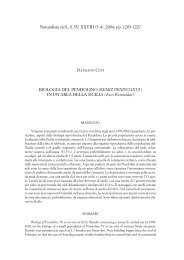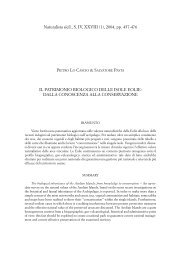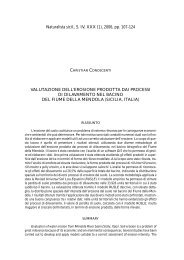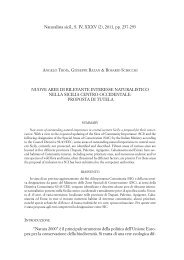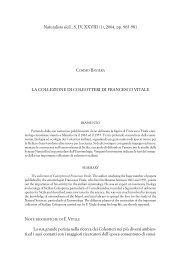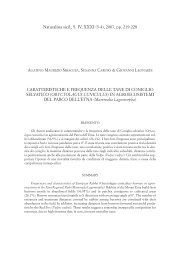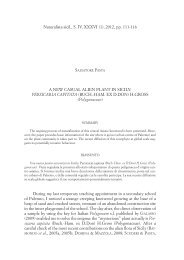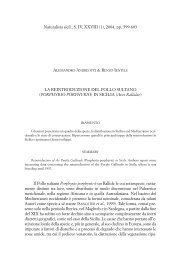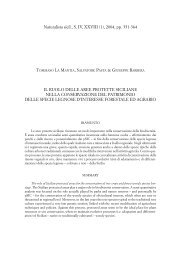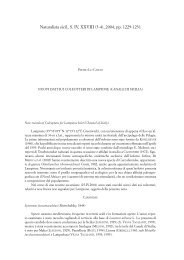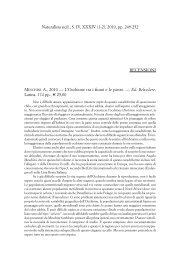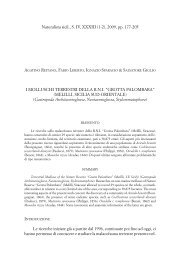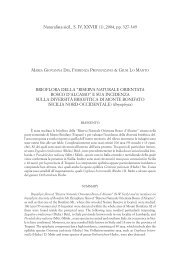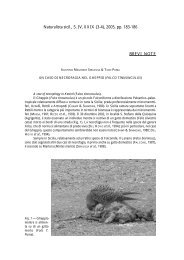2007,pp - Società Siciliana di Scienze Naturali
2007,pp - Società Siciliana di Scienze Naturali
2007,pp - Società Siciliana di Scienze Naturali
Create successful ePaper yourself
Turn your PDF publications into a flip-book with our unique Google optimized e-Paper software.
274 M. SKUHRAVÁ, V. SKUHRAVY´ & B. MASSA<br />
Contarinia coryli (Kaltenbach, 1859)<br />
Syn. Diplosis corylina F. Löw, 1878<br />
Larvae develop in swollen catkins of Corylus avellana L. (Corylaceae).<br />
Only one generation develops in a year. Larvae leave galls in late summer and<br />
in autumn and overwinter in the soil. Adults emerge in the following spring.<br />
Occurrence: DE STEFANI (1906c) recorded this gall from Sicily. Distribution:<br />
Euro-Siberian, reaching up to China; it occurs also in Turkey (SKUHRAVÁ et<br />
al., 2005).<br />
Contarinia craccae (H. Loew, 1850)<br />
Syn. Contarinia craccae Kieffer, 1897<br />
Larvae develop in flower buds of Vicia cracca L. (Fabaceae) mo<strong>di</strong>fying<br />
them in galls (Pl. VIII, Fig. 48). Occurrence: DE STEFANI (1903) found galls<br />
of this species at Palermo on V. dasycarpa and V. sativa.DE STEFANI jr (1942)<br />
reported it from Real Favorita (Palermo) in April-May. Reference: TROTTER<br />
& CECCONI (1900-1917: N. 290 and 374), Palermo, 1905, leg. De Stefani; DE<br />
STEFANI (1906c). Distribution: Euro-Siberian.<br />
Contarinia ilicis Kieffer, 1898<br />
Larvae cause small galls on the leaf of Quercus ilex L. (Fagaceae) with opening<br />
on small pipe on the lower side of leaves. Occurrence: DE STEFANI (1901,<br />
1906c) collected galls at R. Villa La Favorita (Palermo). It is quite common in<br />
Sicily, on areas dominated by woods of Q. ilex. Distribution: Me<strong>di</strong>terranean.<br />
Contarinia minima (Kieffer, 1909)<br />
A solitary larva causes small, conical gall, about 1 mm high, on the leaf<br />
of Quercus ilex L. (Fagaceae). Occurrence: DE STEFANI (1906c) <strong>di</strong>scovered<br />
galls of this species in Sicily, later described by KIEFFER (1909). Distribution:<br />
Me<strong>di</strong>terranean.<br />
Contarinia nasturtii (Kieffer, 1888)<br />
Larvae develop gregariously in flower buds of Nasturtium sp. (Brassicaceae)<br />
and other species and genera of this family. Occurrence: DE STEFANI (1906c)<br />
recorded it from Sicily on Brassica amplexicaulis Janka. DE STEFANI jr (1942) also<br />
reported it from Caltanissetta in May. Distribution: Euro-Siberian, covering a<br />
wide area to the Caucasus; it also occurs in Turkey (SKUHRAVÁ et al., 2005).<br />
Contarinia pyrivora (Riley, 1886)<br />
Larvae live in deformed and enlarged fruits of Pyrus communis L.<br />
(Rosaceae). The damaged fruits are blackened inside. Only one generation



